Should mobile phone charging be a free public service?

We all like something for free but what public services do we deserve to get for free and what should we pay for? If you are required to pay to use a toilet or to access WiFi in a public space, it can leave a bad feeling as the expectation is that these services should always be free. But what about public phone charging? Shouldn’t that be a free public service too?
When ChargeBox launched in 2005 the original idea was that people would happily pay less than the price of a cup of coffee to charge their phone. For the first few years, ChargeBox operated as a pay-to-use service. It wasn’t until a major mall operator approached us in 2011 asking for a free-to-use service for their shoppers, that everything changed.
When we launched our free-to-use service usage increased by over 2000% overnight. People love free phone charging!
Now over 95% of our charging locations are free to use.
But what’s right for your location?
Free to Use:
- Increases customer satisfaction and enhances the experience. Adds to your location’s positive brand identity.
- Facilitates charging at scale. More people using the service means that visitors dwell for longer and are likely to be happier and more satisfied by the ease of being able to stay connected.
- Greater ROI. 100 people using a free service will benefit you exponentially more (additional spending & goodwill) than the revenue 5 people will generate for you by paying for phone charging. (In our experience Pay to Use phone charge volume is ~ 5% of Free to Use phone charge volume.
- A service available to all without discrimination. Yes if people are really in need of a phone charge you could argue that they will pay for it. But what about the people who can’t afford it or have to prioritise what is most essential at that time?
- Less staff intervention is required. A paid service adds an additional layer of complexity to providing a service – more can go wrong.
Pay to Use:
- Limits anti-social behaviour. With payment required and an audit trail back to the user it discourages misuse e.g. kids congregating around a free service.
- Will generate a small direct revenue stream in certain locations, typically ones where people can’t or won’t leave easily e.g. hospitals, casinos and theme parks.
- When a location has zero budget it allows them to offer an essential service at little to no cost.
At ChargeBox we offer both Free to Use and Pay to Use services and ultimately the decision on what is best for your location is down to you. What links our free and pay-for services is that they are both the best charging experiences available.
- The fastest available phone charging. Three to four times faster charging than any alternative solutions.
- Simple and intuitive to use with minimal barriers to get charged up!
When you’re paying for a service these factors become even more critical.
Which service would you lean towards as a business owner? We’d love to hear your views.
Team Chargebox
UK airport rule – Passengers need a charged mobile to fly

From 2014, anyone flying from a UK airport has been expected to show that electronic devices in their hand luggage can be switched on, if requested to do so by Security personnel.
How many of us are actually aware of this rule though?
Mobile phones and other electronic devices are a common part of our everyday lives so we don’t think twice about packing them into hand luggage and jetting off.
However, UK airports and airlines require passengers with phones, laptops and tablets in their hand luggage – to be able to switch on their devices and ensure they have enough charge to do so.
Last month was the first time these little known rules really hit the news and yet many of us will still not be aware that “If you cannot turn on your devices when requested by security personnel, they can take it from you…”. In other words your device could be confiscated.
The official government website states on its travel advice pages, “Make sure your electronic devices are charged before you travel…”
The BA website states: “Airport security staff may ask you to turn on electronic or battery-powered devices, such as phones, tablets, e-books and laptops, to demonstrate they function.
If you’re not able to do this, you will NOT be able to take your device with you.”
Whilst not all passengers are stopped and asked to “switch on” their devices, random spot checks may be carried out at some airport security points so, travellers MUST ensure their devices have at least enough power to switch on, if asked to do so.
Stay charged up folks!
The ChargeBox Team
Chargebox packs in a summer of sizzling events.
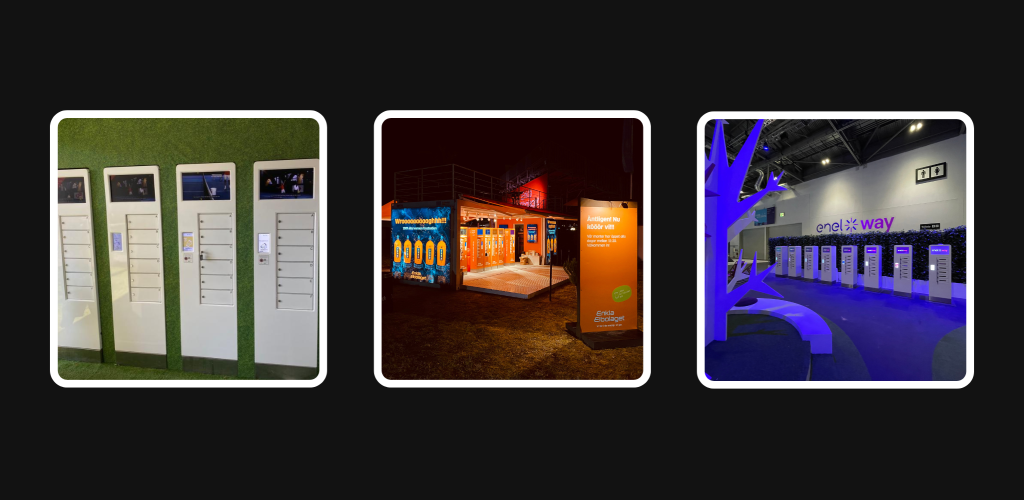
It’s been a hot busy Summer so far and we wouldn’t have it any other way.
We’re pleased to have been picked to provide charging services at many significant events this summer and it’s not over yet.
The season kicked off in the traditional style with our annual pilgrimage to SW19. We’re now in our 9th year of working with the tournament and it’s one of our favourite events to attend. HSBC created customer booths with free device charging to entice spectators. Usage of the service was up an incredible 33% this year from last year demonstrating that, like Emma Radacanu, our service proves to be a firm fan favourite.
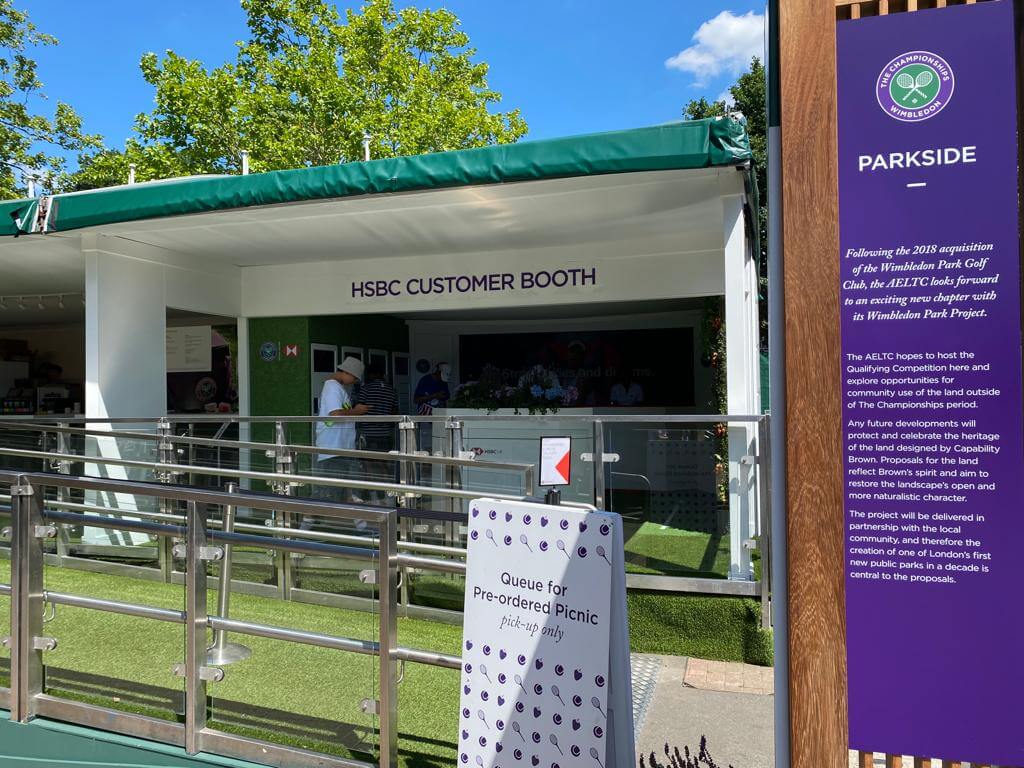
From a much-loved old client to a much-loved new one. A new major sporting event we are delighted to welcome to the fold is Formula E. According to the top driver, Antonio Felix da Costa, the event at Excel London this year was the best yet! Perhaps it was due in part to the fabulous Recharge zone in the Allianz E-Village 😂. Sponsors, enel x way created a perfect area to relax in, with plenty of comfortable seating, low lighting and eight ChargeBox Fast units. With the World’s fastest electric cars on show, this event absolutely had to have the world’s fastest phone charging too!
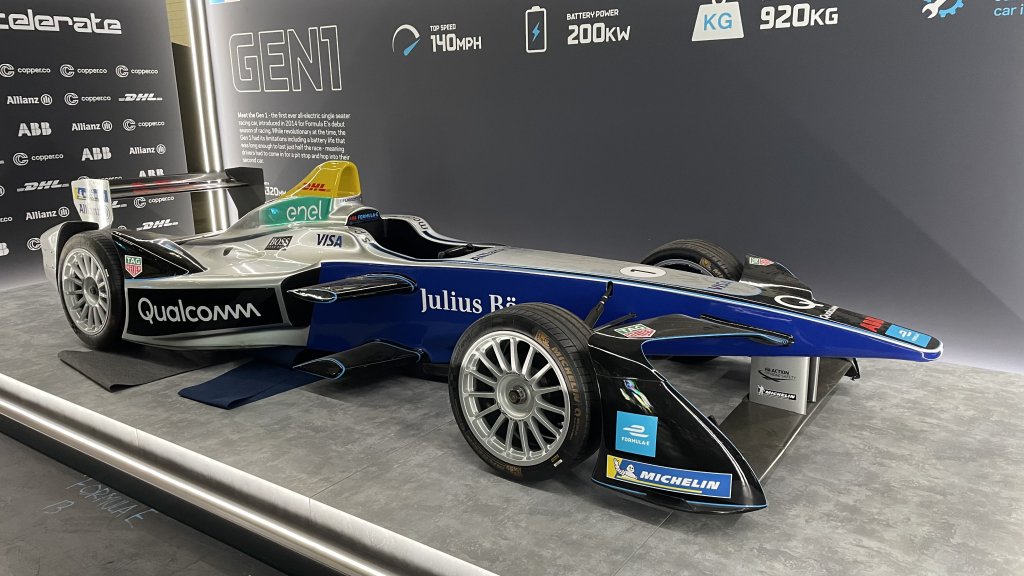
Over in Sweden, our partners at Paraply Production converted a shipping container into a charging zone, in order to provide an essential service at some of Sweden’s biggest music festivals. As part of an activation for utility company Enkla Elbolaget, they upgraded their charging service for 2022. Previously they operated a phone check-in, where staff would take customer phones and plug them in on shelves. This, however, was labour intensive and an organisational headache. ChargeBox’s simple, secure and intuitive lockers are completely self-service so festival goers can independently charge their phones up quickly and easily. Boom!
We’ve also been flying high this summer with some prestigious aviation events, attending both the Air Tattoo and the Farnborough Airshow. Like Wimbledon, the Farnborough Airshow is an event we’ve worked with for many years but post-Covid, we are enormously pleased to be back on the live events scene! Both shows had sponsors supporting their services, these being Raytheon Technologies and Lockheed Martin respectively. Sponsoring charging at events is great for awareness and brands also benefit from the halo effect of providing a useful free service. By securing sponsorship of the service, event partners provide an enhanced experience which negates costs and often makes providing charging, profitable.
Finally a mention of the British Summer Time Festival at Hyde Park. Our services were available to VIP guests of charity supporter Utopia. Just think of the pop royalty who could have used our service – Elton John, Adele, Mick Jagger? Alas, we didn’t get to see any of the gigs ourselves this year but hopefully, we’ll be back again next year to see some of the action!
We’ve had so many great events partners already this summer with more yet to come! Sorry if we didn’t mention your event with us this time.
Get in touch if you’d like us to mention you!
ChargeBox positively impacts the event experience for hundreds of thousands of fans, delegates and attendees. From business conferences to major sporting occasions, we’ll keep your attendees charged and connected.
ChargeBox at the NHS – Small Improvements That Make A Big Impact

The hospital charity that funded the service tweeted about its arrival. 143 Retweets, 85 Quote Tweets and 1,369 Likes later, here are some of the highlights of those responses:
‘Great idea for the new ED build’. ‘Love this! We’ll definitely look at it’. ‘Great idea, something we can think about for @EDQEH1?’ ‘Look at this fab idea! 😍@StarsAppeal’. ‘Great idea for patients’. ‘Can we do this???’. ‘What an amazing idea! Well done.👍’ ‘What a brilliant idea – do we have one of these in our ED?’ NorthMidNHS. ‘Excellent idea!’ “Love this!’
Positive validations from NHS staff continued to flow…
Chief Nursing Officer, Evonne Hunt at Medway NHS Trust said ‘What a brilliant idea!’.
Joel Bonner, Patient Experience Lead at Gloucestershire Hospitals NHS Foundation Trust commented: ‘the sort of thing I had in mind!’ to which Sally Hayes, Deputy Divisional Director Quality & Nursing Medicine said ‘Yep! Saw that last night! Go for it!’
Other comments even made us chuckle as curiosity about the new Chargebox grew. ‘Where do we buy one of these beauties???’ Really, Clare? But thank you 🙏 And Sarah 😂 ’Please can we have one for Christmas?’ ‘How groovy is this!? Yeah, baby!
But Clare Campion, Interim Director of Nursing & Quality at The Children’s Trust and Registered Nurse Brian Webster summed up best why having charged up, connected devices at hospitals are essential.
‘Fantastic initiative, well done! That will make such a difference to people who are there for far longer than they’d like to be, and left home in a hurry without a charged phone, or spare battery. Will take a lot of anxiety away. 👏’
‘Person centredness. I helped someone today in ICU get their phone and tablet charged and WiFi connected then facilitated a video call with family. They didn’t care (verbally) about all the clinical skills I did all day but for this, they couldn’t thank me enough!’
And patient Douglas Bilton also gave us a valuable review of the service. ‘This is such a great idea. I’ve had to go to A&E 3 times this year and on each, phone charging has been a concern.’
So as you can see, keeping patients’ devices charged is essential. We hear this all the time in our conversations with NHS partners so it’s rewarding to see it stated openly and genuinely for all to see.
About ChargeBox:
ChargeBox is the trusted, safe and secure charging provider at over twenty NHS Trusts because our service will:
Alleviate stress as patients and visitors can stay connected with loved ones, access critical information and stay entertained.
Increase staff productivity as they no longer have to deal with charging requests.
Support the increased volume of mobile devices within the NHS as pagers are phased out.
Reduce the uncontrolled use of sockets which can result in health and safety risks – Estate and Facilities Alert Dec 2018
Tell us about your local hospital – is device charging a service you think is essential these days?.
Fast charging and protecting your smart phone’s battery life.

Do you want to charge your smart phone safely and keep the battery life good for as long as possible?
Are you surprised at how slowly your smart phone appears to charge sometimes?
Are you confused by the different cables and chargers around?
If you answered yes to just one of these, you’ve come to the right place…
Your smart phone’s Lithium-Ion battery is an incredibly sophisticated component that has evolved to supply reliable power for much of the day, safely, and for an extended lifetime of 1,000 charges.
Over those 1,000 charges, your battery will start to deteriorate and not yield the life it had when it was new.
A key way to reduce that degradation is NOT to charge it past 80-90% if you don’t have to and ideally keep it above 10-20%. This may mean charging it twice daily to keep it in that range and skipping overnight charging to 100%.
Like most people, you’ve probably got several chargers you’ve received with smart phone purchases over the years.
If you’re still using the charger that came with a smartphone just a few years ago, you need to change it!

👈 If you are using one of these to charge your iPhone 8 onwards, it’s only providing between 18-30% of the power your smart phone needs.
In other words, your smart phone could be charging up to five times slower than it’s capable of. 😳
Why Battery Size Matters
Smart phones now have 3-4X more battery capacity than just a decade ago. You may not have noticed the change as it has been a gradual change in line with smart phones getting thinner. While some of that capacity provides better battery life, more is used because smartphones now have giant screens and are more power-hungry. What could charge a smart phone a decade ago will only give you a fraction of the power needed now.
To understand if your smartphone is getting a meaningful charge, you should measure it in terms of the % battery boost in a particular timeframe, e.g. 0-50% battery in 30 minutes.
Using an old charger with your new smartphone may take over 2 hours to get a meaningful charge. Of course, that’s not a lot of use when you’ve only got 10 minutes to get out of the house.
So what’s the answer?
Faster charging. The first iteration was QuickCharge from Qualcomm. This allowed slightly quicker charging using the micro-USB cable. However, it was proprietary and generally limited to specific Android devices that used Qualcomm components (by no means all). Plus, it was limited to the inferior micro-USB cable, which breaks easily.
Now USB is leading the way in providing fast charging standards developed and agreed upon by a cross-industry group, including leading vendors such as Apple, Samsung, and Google, as well as chip companies such as Intel and Texas Instruments.
They developed a better cable ending – USB-C – and the next-generation USB charging technology known rather boringly as USB Power Delivery (PD). It’s now considered the only true Fast Charge technology for smart phones, which is also compatible with laptops and tablets.
How does USB PD work in the simplest terms?
Well, it’s actually quite straightforward. Power, measured in Watts, is simply Volts multiplied by Amps. So, with old USB charging, you might have between 5W and 12W of power (at best). But with USB PD, chargers can go all the way to 100W – over 8 times more power or 20x more power than the typical 5W chargers many people still use! (Remember that Apple charger above?)
Most smart phones today charge in the 20W-45W bracket, so a PD charger offering anywhere from 20W to 45W is good enough. But if you use a higher power charger made for a larger laptop or tablet, that’s even better. Of course, you don’t need a 100W USB PD charger, but neither will it do any harm.
USB PD continues to develop and is being stretched to 240W of power in the next generation. This could permit e-bike/e-scooter or power tool batteries to be charged while also permitting charging some of the largest laptops or powering small desktops.
Qualcomm has adopted USB PD in its QuickCharge4 standard, meaning devices supporting QC4 will also support USB PD chargers. In addition, Apple’s Lightning cable (with a USB-C adapter on the charger end) also supports USB PD chargers.
Am I using USB PD Fast Charge today?
If your charger has a USB-C port, it may be USB PD, but not definitively. If you can find the specs, look for USB PD to be mentioned and voltage levels other than 5V (e.g. 9V) and/or power of 18W or more.
If your charger has a USB-A socket, it is definitely NOT a USB PD fast charge charger. And just because your smart phone has a USB-C socket does NOT mean it’s a smart phone capable of USB PD Fast charging.
And finally.
We’ve not discussed loads of geeky terms here, such as Wh, or mAh but it is REALLY useful to understand a very simple relationship. Watts = power. A Wh or Watthour is simply the amount of power that can be sustained for one hour – so you can be a powerful runner with a quick sprint, but a one-hour run is the power you can maintain for one hour – “energy”.
In electrical terms, there are two key components that make up power; Volts and Current (amps). Multiply the two, and you get the Watts. Maintain that for one hour and you get Watthours. So, 5V * 1A = 5 Watts. Maintain that for 1 hour and you get 5Wh of energy – a smartphone that runs at 1Wh will get you 5 hours of usage.
So there it is. Fast charging in a nutshell.
One Charging Cable – A Great Idea?

On the surface, what is there not to like? Well, quite a lot actually.
Bureaucrats and politicians interfering in technology innovation is never a good thing, and this is no exception.
Have we suddenly reached peak cable where no further innovation is necessary?
There are some reasons for having a universal cable – to reduce e-Waste, extend the life of a charging system and simplify things for consumers. But, if the result stifles innovation, these small benefits are far outweighed.
The EU attempted this several years ago when the common cable type was Micro-USB. Was this the ultimate cable? It certainly wasn’t. For starters, it has a non-reversible end which causes damage to cables and devices as users struggle to insert it the right way up. Micro-USB continues to limp on but is dramatically declining, accounting for less than 10% of the phone charges we deliver.
If Micro-USB had been mandated years ago, we’d be stuck with an inferior solution. We wouldn’t be seeing the increasing number of larger devices that use USB Power Delivery charging, which is impossible with Micro-USB. We’d also be stuck with bad chargers for phones needing alternative chargers around our homes and workplaces for other devices instead of sharing cables.
Forcing such a change will also render equipment useless, potentially creating more e-Waste and further consumer cost. For example, the car industry works on a much slower innovation cycle. If your AV equipment in your brand new car supports your Apple iPhone via Lightning, but that system cannot support your next phone, what will that mean for you and your vehicle?
How can EU politicians judge the limits imposed on technology vendors and prevent us from choosing something else when those vendors are incentivised to make our lives better?
We firmly believe any intervention in this area is bad because it will stifle innovation and potentially productivity by limiting what innovations can be deployed.
Wireless charging doesn’t plug into the phone but requires an alternative connection. If that’s allowed, why not something else? We’d be forcing our devices to have ports that limit waterproofing and dust proofing if it’s not allowed. There may be details in the EU proposals that outline these, but we can’t be sure since the situation is evolving.
If the EU IS determined to mandate something and reduce e-waste, then surely it should be focused on the other two elements of charging:-
- The charger itself has considerably more environmental impact than a cable
- Having a standard protocol such as USB Power Delivery
However, this too requires caution as USB PD covers everything from a 15W charger suitable for small phones to 100W chargers for laptops. Indeed the next version of USB PD will support 240W charging – capable of charging the most power-hungry laptops as well as e-bike batteries, power tool batteries and a whole host of other things.
In summary, the EU should not interfere in areas that have the potential to limit innovation and productivity. But if they have to do anything, then perhaps the focus should be on quality chargers that are safe, reliable and power-efficient and that use a standard charging protocol such as USB-PD. This would be far more beneficial to consumers and the environment alike.
The EU should also lobby the USB Implementers Forum to make sure consumers understand that charger, charging standard, and cable permutations are many – and all impact performance.
Change doesn’t have to happen overnight – but to prevent change altogether would be disastrous.
Our Sustainability Strategy
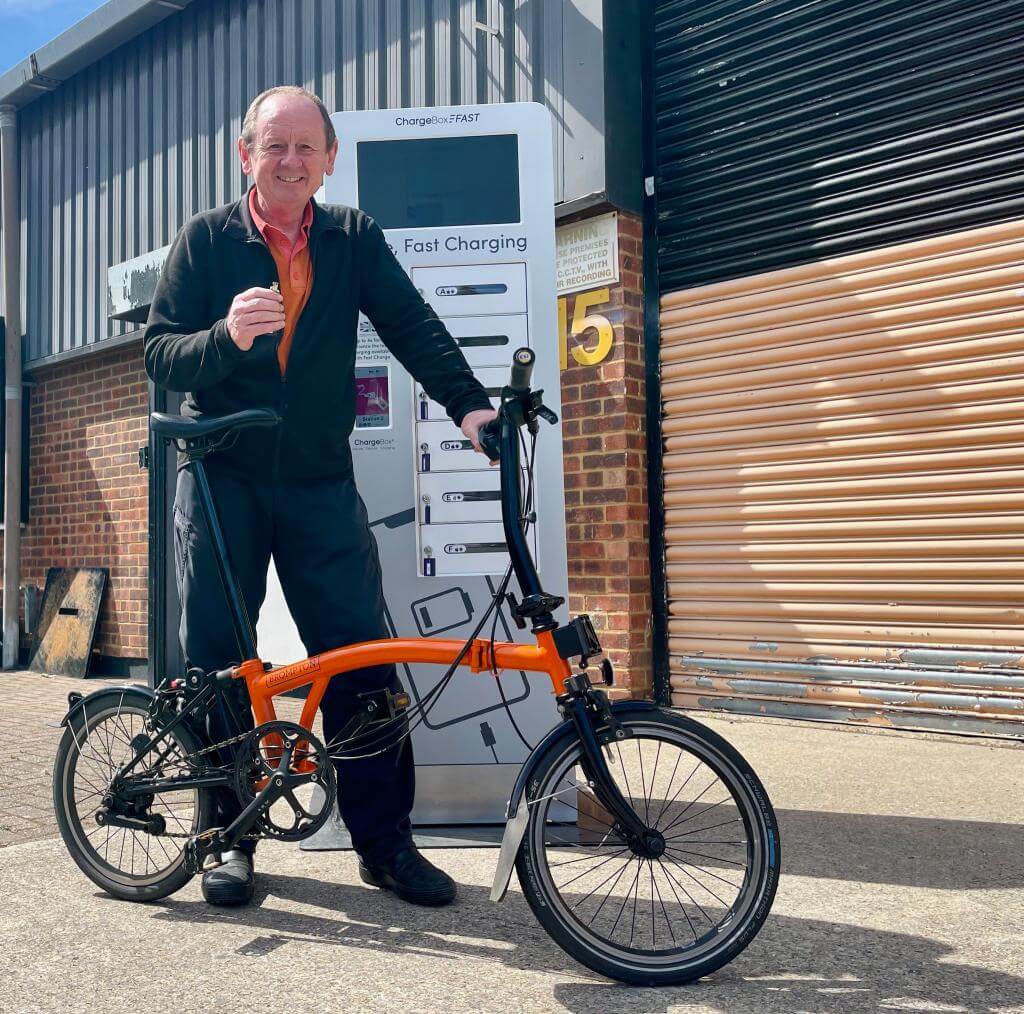
Sustainability and the Environment are dear to us all at ChargeBox. However, these are not just words; we are taking tangible actions to make our company sustainable and make the products and services we provide to our clients sustainable.
In 2021, ChargeBox committed to NetZero by 2030, which can be seen on the SME Climate Hub. Also, in 2021, ChargeBox was part of the first cohort of businesses to go through the BetterFutures+ programme, developed by West London Business, with the backing of the Mayor of London.

The mix of workshops designed by Imperial College Business School, a carbon calculator and a consultancy project focused on embedded carbon inside ChargeBox, has given us an accurate insight into our emissions and those created by our suppliers. As well as those taken on by our clients when they purchase or rent our ChargeBox solutions.

Credit: https://unsplash.com/@nrdoherty
“With the addition of a heat pump, solar thermal hot water, and solar PV, I’ve chosen to make my own dwelling zero carbon and invested in a wind farm to produce 120% of the electricity required – even while purchasing renewable energy. For as long as I can remember, I have cycled to work and back every day.” Ian
We are especially delighted to work with clients committed to NetZero. And we will provide any information and mitigations to you to help you achieve your commitments and interim goals.
Like any business, we have our emissions and waste. However, we have taken significant steps to use renewable energy for our premises and recycle everything we have to dispose of with zero landfill. These efforts really help on our Scope 1 and Scope 2 emissions. We also have a cycle-to-work scheme and encourage our staff to use public transport to support deployed ChargeBox stations.
However, we learned from our BetterFutures+ experience that our biggest challenge is to reduce our Scope 3 emissions – those we do not directly output – as they are emissions of our suppliers and clients as a consequence of providing the service. We estimate these emissions to represent over 93% of total emissions, and so represent a far bigger prize to impact than just our own direct emissions.
To provide the World’s best charging solutions, we have developed great designs and user experiences built around quality materials and leading-edge electronics. Materials (e.g. steel, stainless steel, aluminium) and computer boards, wiring, PCBs etc., all have a sustainability impact and emissions impact. Because we control those designs, we have calculated the impact of embedded carbon at manufacture and lifecycle emissions during use. We can also reduce those emissions through supplier choice, component choice, design changes, and recycling/reuse, making our solutions more sustainable.

Here are the things we’ve already done:
- Since 2019 we have manufactured all of our solutions at a UK factory, minimising long-distance logistics and ensuring control of what goes into every ChargeBox. In addition, our factory has a solar PV system that generates over 0.5MW of electricity – larger than 150 home installations.
- Our primary manufacturer works with UK and European suppliers to source primary metals and is constantly looking at ways to choose lower emissions and more sustainable materials, particularly aluminium produced using renewable energy or newer processes for stainless and mild steel.
- Because of these actions above, we estimate that around 95% by value of components and work to make a ChargeBox is kept within the UK and EU. With competitors often sourced from Asia – often from countries with high carbon electricity generation – this figure is likely the other way around for them. By keeping the value locally we help the UK economy with well-paid jobs, while also being much more in control of emissions during manufacturing. Emissions from long distance transport – usually by high emissions cargo ships are almost totally eliminated. By the time a ChargeBox reaches our warehouse – we’re miles ahead on embedded emissions.
- We have always strived for low-power components. Our Raspberry Pi main computers – also designed and manufactured in the UK – have extremely low power usage. And our other electronics means that when in idle mode and not charging any phones, ChargeBox will use as little as 6W of electricity – less than 1/10th of an old lightbulb. Our larger units with top screens idle at around 22W – still less than 1/3 of a lightbulb. Charging a phone uses comparatively little power, but 1 unit of electricity is enough to charge around 30-40 phones, 15 tablets or 5 laptops*.
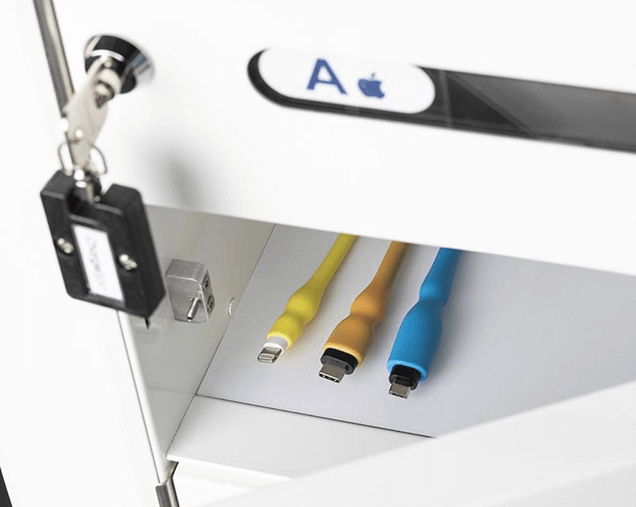
- We are on our 3rd generation of cable enhancement. A typical Apple iPhone cable may only last for 200-400 uses, but our cables last for over 4000 uses. Fewer cable changes saves materials and reduces service visits to fix while also improving availability.
- While our 3rd generation ChargeBox has the best and most reliable design ever, with almost everything changed, we have also recognised that some components from end-of-life solutions are still just as good and can be re-used. We give a lifetime warranty on these components and have reduced the embedded carbon in our latest stations by 15%. We will continue to iterate our designs and choice of materials suppliers to reduce this figure further.
- Our IT services are all cloud-based, and we use a supplier that will be carbon neutral before the end of 2025.
- We continue to work with our primary suppliers to encourage their own NetZero journey.
- We now offer to all our clients who are upgrading or retiring units to responsibly recycle, retest and reuse and can provide appropriate guarantees to clients. You can therefore be sure that metals used in any ChargeBox will be recycled, and electronics and wiring will either be re-used, repurposed, or responsibly disposed of. In addition, we are committed to incremental reductions in the embedded carbon of our solutions over their lifetime. We will also ensure they are not a burden to our clients at end-of-life.
- Many of our solutions are heavy and require complex logistics to ship across the UK or abroad. We outsource much of this to professional logistics and delivery companies. Right now, there are no suitable zero-carbon methods for moving equipment long distances, but we will continue to work with suppliers to adopt such practices when they become available.
- When we do our own deliveries, we are now trying to source lower carbon or zero-carbon transportation. This is easier around our base in London, but zero-emissions logistics for moving our heavy items around even short distances are not there yet. However, with the steps we’ve taken, we estimate that we will use 10% less carbon in our logistics emissions in 2022 over 2019, and we expect these savings to accelerate.
- We use a protective wrap on most ChargeBox solutions for permanent installation or events. This helps extend the unit’s life but is also used for sponsorship and branding. We sourced the most environmentally friendly wrap solution from 3M via a key supplier who is committed to sustainability. We also now do this in-house, eliminating shipping of panels there and back.
We are all on this sustainable journey together. We’ll be sharing regular updates and blogs about our progress. If you’re interested in our journey, follow us on Twitter, LinkedIn and Instagram to see how we’re getting on.
Ian Hobson
Founder & CEO, ChargeBox
* these are considered approximate numbers and can vary significantly between products.
Smart Lock vs PIN
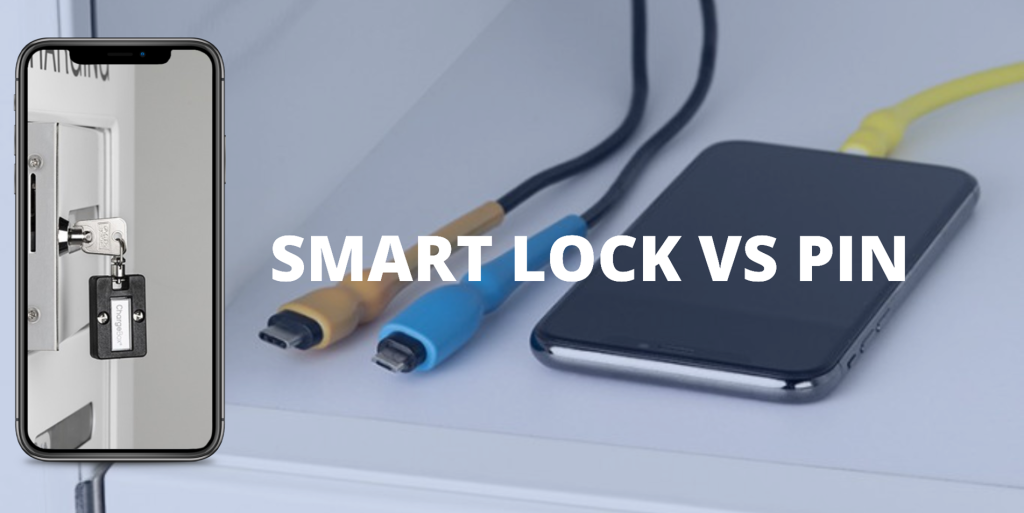
In this digital age, is it surprising to learn that key security still firmly trumps a PIN or a futuristic biometric system?
We patented our smart lock for charging lockers back in 2013, and it is still as relevant and market-leading today.
We thoroughly explored the alternatives in our quest for the ultimate locker security. But even now, in 2022, we still get asked about PIN lockers and how they compare.
To understand the limitations and benefits of a PIN-based system, we built one as a prototype and put it to the test. We trialled it in a Central London location and then sat back to observe usage on the CCTV.
On one occasion, we watched someone using the locker correctly, followed by someone else getting up from a nearby sofa, going to the same locker, typing in the PIN and stealing the device. The phone owner had done nothing wrong but found their device gone through no fault of their own.
This is just one example I hear you say. However, that alone doesn’t make key security better than a PIN. Surely there are ways PIN systems could be as good or better than a key?
We think not. Here are seven rock-solid reasons why key trumps PIN every time.
Security:
- It is pretty easy to see peoples’ keystrokes, especially when they’re unfamiliar with the system and do it slowly. Typically a user-selected PIN must be confirmed, which gives a thief a second opportunity to spot the PIN.
- Even with a six-digit PIN, anyone can remember a sequence of 6 digits. And it’s super-easy for someone standing behind to video a user entering a complex PIN.
- Preventing users from choosing common PINs (e.g. 123456) will reduce successful guesswork. Still, it’s not enough unless you also reduce how many attempts are allowed. This can create another problem, though – locking the genuine user from retrieving their device!
Ease of use:
- It is significantly more time-consuming and tricky for users to create a PIN (that passes the uniqueness test). You can easily spend a few minutes setting up a PIN system – while it’s just a few seconds to use a key. That gives more charging time and means the machine is quickly available for following users.
- What happens if a user forgets their PIN or gets locked out? Staff interventions to release the device and put the locker back in service. Even if this happens with 1 user in 100, it means staff interventions at busy locations every day.
Practicality:
- Without clever design, a PIN system makes it easy for a user to lock an empty locker and leave it that way, reducing service availability. Of course, this won’t happen everywhere, but anti-social behaviour is a risk in specific locations.
- What happens if a PIN security machine loses power (the site loses power, or the machine fails)? If this happens, there are two choices – open all the doors or keep them all locked. Neither answer is satisfactory, though the former is, of course, the worst. Would this also happen with a ChargeBox? Fortunately, the answer is “No”. If the power source goes down, all you need is the key to retrieve your device, as it’s only a mechanical process to unlock it.
But come on, there must be some bad things about a key?
Well, you have to carry it around with you, and it’s possible to lose one. However, in our experience of charging over 50 million phones, this happens to less than 1 in 50,000 charges. The host site can open the locker with an emergency key and retrieve the device subject to certain security checks if it does. All the while, our systems record every event down to the second and transmit this to our servers – e.g. door locked, charging started, cable disconnected, etc. So we can back up any truthful story with our audit trail, and if someone is not telling the truth, we can see that too.
So OK, a PIN is maybe not such a great idea, but biometric security is undoubtedly the future. After all, that’s what I use on my phone these days, and they can’t steal that, and I can’t lose it.
We’d welcome reliable biometric systems, but it’s far from reliable. Fingerprint-based and face profiles are two common biometric systems. You know it takes time to set up if you’ve used these before. And these are state-of-the-art systems by some of the world’s best technology manufacturers. Using biometrics, a phone charging locker is slow to use, insecure, or both.
Even worse is the assumption that a biometric reader will remain clean and fully functional. Used many times a day with many different fingerprints – dirty, wet etc., will affect performance. In addition, users will not be able to use the locker or retrieve their device resulting in more poor service and high staff interventions.
And of course, just as for PIN, if power is lost, so are your chances of retrieving your device.So, that is why we use keys – and we suspect why you use keys to secure your property too.
The 5 things you MUST consider when providing a public charging service

The importance of our mobile devices has never been in doubt. Most adults couldn’t cope without their mobile phones for more than a day. So, while we’re surprised that 1 in 7 of us use our phone as a mirror (you vain bunch!) we’re not surprised that 55% of people describe running low on phone battery as their ‘nightmare scenario’.
That’s because we use our mobile phones for everything. The days of paper train tickets and pound coins are long gone. And who can imagine a physical COVID passport?? If we’re not sharing things with our friends, family and social followers we’re filling in the time on the bus with ‘All of Us Are Dead’.
When you consider the essential services you offer, phone charging should be at the top of the list in this digital age. Free Wi-Fi is a common service, but what use is Wi-Fi if your phone is dead or you’re scared to use it because you want to preserve the last dribble of battery?
SO, if you appreciate the importance of mobile devices in the customer journey and want to support their usage in your environment these are the 5 things you MUST consider when providing a charging service:
When you need to charge your phone what will be the measure of satisfaction with a service? What % battery you get in a short period of time of course. Getting a 7% battery charge in 10 minutes is just…well a bit meh. Genuine fast charging can take you from zero to 20% battery in just 10 minutes. An experience that truly delights. The speed and depth of charge you provide are absolutely key.
Read the instructions, download an app, fill in your payment details. No thanks. I just need to charge my phone! A service that is intuitive and easy to use saves people time and confusion and ensures the greatest adoption of your new customer experience.
Who is responsible for a mobile device if it gets damaged or stolen whilst charging? If a provider doesn’t use manufacturer-approved components in their solutions it increases the likelihood of delivering an unsafe charge. Ask providers if they will take responsibility and guarantee the safety and security of mobile devices for you?
You should be buying a service that will last for many years and provide a reliable and continuous service day in day out. With whatever solution you choose something will go wrong eventually, it’s just what happens when providing a service in a busy public environment. How do you mitigate that and what support do you need to ensure a reliable and continuous customer experience?
Technology changes fast. The majority of phone charging providers’ technology is already out of date. Take battery pack rentals, for example, the maximum charging power they can deliver is between 7.5-10W. The new Samsung S22 Ultra can take a charge of 45W. A battery pack isn’t going to give an effective charge. And phone power requirements and battery size will only get bigger. The way of delivering a charge will also change (although we’d leave rooms that wirelessly charge to plot for a Wes Craven movie). A service that is future-proofed for the inevitable innovation in mobile technology is key and will save you more money in the long run.
If you want to know what ChargeBox thinks is important when providing the best experience for the venue and user then get in touch. We’re also happy to chat about our favourite movies.
